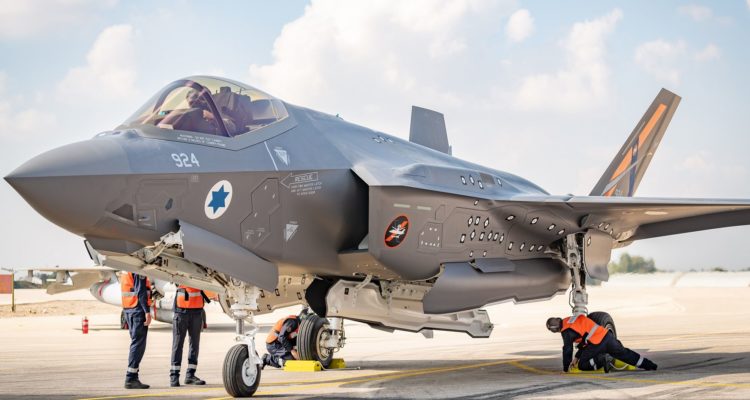The Israeli pilots are as good as any on the planet, and the latest additions to Israel’s fleet of F35s, which ultimately will number 75, will guarantee the Jewish state’s air superiority for many years to come.
By Hugh Fitzgerald, Frontpage Magazine
Israeli pilots are rated as among the best in the world. Some say they are the best in the world. Think of what they did in just three hours on June 5, 1967, the first day of the Six-Day War, when Israeli pilots destroyed 419 combat aircraft belonging to Egypt that were still on the ground at fourteen airports and air bases.
On June 4, Israel had 250 combat aircraft at its disposal, while its enemies had 600. The IAF destroyed a total of 452 enemy (Egyptian, Syrian, and Jordanian) aircraft, including 79 in air combat, while losing only one-tenth that number — 46 — of its own.
Think of the Israeli and Syrian planes going head to head in June 1982, with the result that 82 Syrian planes were shot down without the loss of a single plane by Israel.
Or think of the Israeli planes that flew deep inside Iran last October 26, destroying all of Iran’s air defenses, including its four S-300 anti-missile systems, a plant that produced fuel for ballistic missiles, and secret nuclear facilities at Parchin.
Or think of the thousands of sorties flown by Israeli planes over Gaza, without a single plane being hit by Hamas.
Now Israel has just taken delivery of three more of the top-of-the-line fighter jets, Lockheed Martin’s F-35, bringing its total of F-35s to 42, with another eight already paid for by Israel soon to be delivered.
Israel intends to have a total of 75 F-35s within just a few years. More on that delivery, and what else will soon be in the IAF’s arsenal, can be found here:
“WATCH: IDF strengthens air dominance with latest F-35 arrivals,” by Yonah Jeremy Bob, Jerusalem Post, March 16, 2025:
“The IDF announced on Sunday that three F-35i aircraft have landed at Nevatim Air Force Base, purchased from US defense giant Lockheed Martin, which increases Israel’s quantity of F-35 aircraft to 42 out of 50, which are already fully purchased.
These three aircrafts actually arrived last week but were only announced on Sunday as part of a long-standing deal spaced over a period of years to raise Israel from 25 to 50 F-35s.
The Jerusalem Post has learned that in around two more months, three more aircraft will be delivered, with another three being delivered later in 2025 and the last two of the existing order in 2026.
But that is not the end of F-35 deliveries.
In 2023, Israel, the US government, and Lockheed Martin signed a deal for 25 additional F-35s to eventually raise the number of aircraft to 75, which will mean a third squadron, and additional steps in that process took place in mid-2024….
In addition, over the course of the war, the IDF said that it modified its F-35 aircraft to be able to fire JDAM munitions from its wings as opposed to its original design of dropping munitions out of the aircraft’s belly.
Even before the war, the F-35 was considered crucial in the MABAM “war between wars” against Iranian proxies in Syria.
It has stealth technology, which makes it more able to strike targets throughout the Middle East with impunity, and its surveillance and intelligence capabilities far exceed Israel’s older F-16 and F-15 aircraft.
For example, it is said to be easily capable of outwitting Iran’s S-300 anti-aircraft missile defense system, and possibly even the S-400 system, whereas other Israeli aircraft would have more trouble….”
That ability was conclusively demonstrated on October 26, when Israeli F-35s flew more than 2,000 mile to Iran and back.
Within a few hours, the IAF had destroyed all of Iran’s anti-aircraft missile systems, including four S-300 systems, taken out a manufacturing plant that produced the fuel used by ballistic missiles, and a secret nuclear facility at Parchin.
“After years of delay, the Defense Ministry has been moving forward with 25 F-15 EX Boeing fighters from the US to help replace its aging F-15 aircraft.”
The IAF has been replacing those “aging” F-15 planes with updated versions of the same plane, the F15EX.
As the Lockheed Martin handout says — and not being an aeronautical engineer I pass this information on without understanding it — the F-15EX has “the digital fly-by-wire control system and the increased dynamic thrust envelope of the F110-129 engines provide it with substantially improved maneuverability and handling characteristics over” those of the older F-15. Sounds good to me.
The one plane that the IAF may need to borrow from the Americans if it decides to destroy Iran’s nuclear program is the B-52 Stealth bomber, which is able to carry the 30,000-pound bunker buster bombs that would be needed if Israel is to destroy the nuclear facilities built underground at Natanz and deep inside a mountain at Fordow.
The Israeli pilots are as good as any on the planet. And the latest additions to Israel’s fleet of F35s, which ultimately will number 75, will guarantee the Jewish state’s air superiority for many years to come.
Israeli pilots have flown 15,000 flight hours in their F-35s, in Gaza, Lebanon, Syria, and Yemen, which means tens of thousands of individual flights. They didn’t lose a single plane.
And their pilots have gained hugely valuable experience flying those F-35s, not just in Gaza, but in their attacks on faraway targets in Iran and Yemen.
The Israelis have also modified their F-35s to improve their performance. Now those planes are able to fire JDAM munitions from their wings, as opposed to dropping munitions out of the aircraft’s belly.
This modification may be copied on some of the F-35s in the American arsenal. Not for the first time, the Americans will have benefited from Israeli improvements to American weapons.





